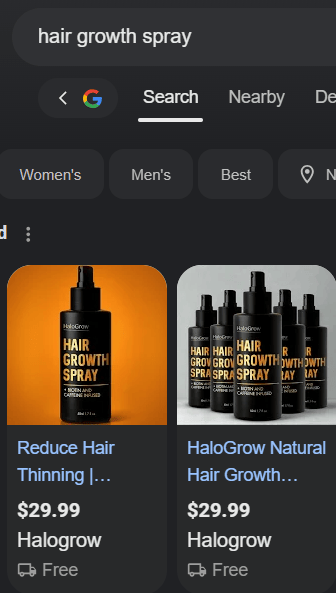- The Echelonn Newsletter
- Posts
- The Shopping Ads strategy every top brand uses (but won't tell you)
The Shopping Ads strategy every top brand uses (but won't tell you)
How to appear 2 or 3 times in the Shopping carousel

One of the toughest challenges in Shopping Ads is standing out in the carousel.
Shopping is a unique platform where your ads sit right next to your competitors…
And in that environment, having a good ad isn't enough
When shoppers type in a search query, they’ll see a row of ads that look nearly identical to each other.
And they’re going to compare your ad against everyone else in that lineup.
Which means…
Your listing needs to be visibly different (or better) than the others sitting in that carousel.
Now, here's where it gets tricky…
In a lot of markets, your competitors will get the fundamentals right…
Titles, product images, ratings, all that stuff will be optimized.
So when everyone's doing the basics well, how do you differentiate yourself?
I'll tell you a simple way to do it:
Be the first and the most frequent option users see.
Take a look at these 2 ads:

They’re selling the same product, using the same landing page… just with different titles and images.
And both ads appear in the top positions.
This gives you two opportunities to capture attention instead of just one like other brands do.
On top of that…
These two ads target different angles through both their titles and images.
You’re not just doubling our visibility for this one search, "hair growth spray."
You’re also increasing our chances of showing up for related searches like "hair spray to reduce thinning" or "natural hair spray."
So that's the benefit.
Now, let me show you how to actually implement this.
To make this work properly, there’s one thing you need to accomplish:
Make Google recognize that each of these listings provides unique value to users.
Whether that’s solving a problem, appealing to a demographic, or highlighting a benefit… it needs to serve a specific user need.
If the algorithm interprets these as two identical ads…
They will simply flag you for violating their policies.
The sooner you grasp this, the easier the implementation becomes.
The first step is using a tool like DataFeedWatch to create multiple product feeds.
In each feed, modify the titles or the images so that each variation highlights a different angle or selling point, such as:
Problems or benefits (back pain relief vs knee pain relief)
Demographics (men's running shoes vs women's running shoes)
Use cases (office chair vs gaming chair vs standing desk)
For example, one feed might feature "office desk" in the title with a clean product shot.
Another feed could use "ergonomic back pain relief desk" with a lifestyle image showing the product in use.
Of course, these angles should be grounded in search data
If no one’s searching for that phrase, your ads won’t rank in the carousel and you’ll just waste your time.
Once your feeds are ready, treat each one as if it’s its own product.
That means applying all the standard principles:
Campaign setup
Landing page alignment
Feed optimization
Negative keyword
Bidding & Budget
Now, you’re probably wondering…
“Does this violate Google’s policies?”
I’ve seen videos calling this strategy “black hat” and “will get your account banned.”
But the truth is…
Google doesn’t care that you’re advertising the “same product.”
As I said above, it cares whether each listing adds value to the user’s search experience.
That's a very important distinction.
If each listing addresses a specific user need and, as a result, improves their experience…
Google has no problem with it.
We’ve been using it to help our clients scale for years without any issues.
As long as you stay within Google’s T&C, it’s perfectly safe (and incredibly effective).
Jackson
CEO & Founder of Echelonn

How we can help:
Get a free Google ads audit: For brands spending more than $20k/mo. or making over 1 million annually, we’ll identify the key bottlenecks in your account, and turn it into a free 90-day scaling plan. Click here.
How did you like this article?Choose below |
P.S. Got a friend interested in Google ads? Share the love and send them our way.
If you’re that awesome friend, you can subscribe here.